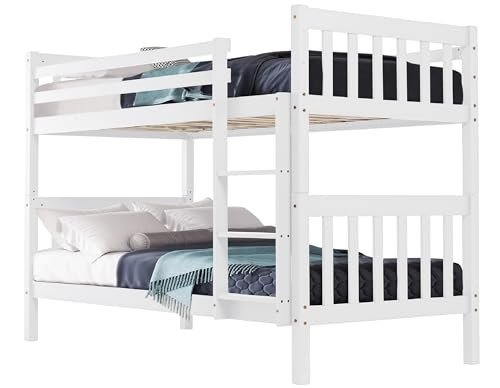The Ultimate Guide to Bunk Beds for Kids: Safety, Styles, and Solutions
Bunk beds have long been a popular option among parents looking for to optimize space in their kids's bed rooms. With benefits that go beyond their compact design, bunk beds provide a fun and practical sleeping plan while motivating brother or sister bonding and fostering creativity. In this extensive guide, we check out different aspects of bunk beds for kids, including security considerations, various styles readily available, and recommendations for choosing the best one for your family.
Why Choose Bunk Beds?
Bunk beds are designed to stack one bed on top of another, using vertical space to create more room for play and storage. They are particularly useful for families with multiple kids or restricted bed room space. Additionally, they supply an adventurous sleeping environment that kids frequently take pleasure in.
Secret Advantages of Bunk Beds:
- Space-saving style: Ideal for small spaces or shared spaces.
- Affordable: Often more economical than purchasing two separate beds.
- Motivates social interaction: Promotes bonding among brother or sisters or good friends.
- Flexible options: Available in numerous styles and configurations to match any space style.
Security First: Essential Considerations
When choosing a bunk bed for kids, security must be the leading concern. The following features are vital for guaranteeing a safe and secure sleeping environment:
Important Safety Features:
- Sturdy Construction: Ensure that the bed frame is made from resilient products such as solid wood or metal.
- Guardrails: Bunk beds ought to have guardrails on both sides of the upper bunk to avoid falls.
- Ladder Safety: A sturdy, built-in ladder or stairs with anti-slip rungs is vital for safe access to the leading bunk.
- Weight Limit: Check the manufacturer's weight limit capability for both the top and bottom bunk.
- Mattress Size: Use the proper mattress size as specified by the bed maker to ensure a snug fit within the bed frame.
Security Tips for Parents:
- Monitor Sleep Habits: Teach children the significance of not playing on or leaping off the bunk beds.
- Age Appropriateness: Generally, the upper bunk appropriates for kids aged 6 and older.
- Routine Inspections: Periodically look for any loose bolts, screws, or structural damage.
Styles of Bunk Beds
Bunk beds come in a variety of designs, allowing parents to choose one that complements their kid's space design while meeting specific needs. Below are some popular designs:
Popular Bunk Bed Styles:
- Traditional Bunk Beds: Simple and traditional designs made from wood or metal with no extra features.
- Loft Beds: Features a raised top bunk with space underneath for a desk, play area, or extra storage.
- L-Shaped Bunk Beds: Arranged in an L-shape, often perfect for corner spaces and can have extra storage choices.
- Twin over Full Bunk Beds: A twin bed on the top and a larger full-sized bed on the bottom, accommodating kids or teens of different ages.
- Triple Bunk Beds: Designed to fit 3 beds in a single footprint, ideal for bigger families or sleepovers.
A Comparison of Bunk Bed Styles
| Bunk Bed Style | Description | Best For |
|---|---|---|
| Conventional | Timeless design with 2 stacked beds | Standard bed room setups |
| Loft Bed | Raised bed with usable space below | Homework or play areas |
| L-Shaped | Bunk beds organized in an L-shape | Corner areas |
| Twin over Full | Twin bed on top, complete bed below | Various age siblings |
| Triple Bunk | 3 stacked beds | Big households or sleepovers |
Picking the Right Bunk Bed
When browsing for the ideal bunk bed, consider the following factors to ensure you make a notified decision:
Key Factors to Consider:
- Room Size: Measure the space measurements to determine the suitable size and height of the bunk bed.
- Kid's Age: Consider the age of your child(ren) when picking a design and safety features.
- Performance: Think about just how much storage or play space you require and whether the bunk bed need to serve additional purposes.
- Spending plan: Set a budget plan that consists of not just the bunk bed but also the needed bed mattress and devices like bed linen or safety gates.
FAQs About Bunk Beds for Kids
1. What age is proper for a kid to oversleep the leading bunk?
Generally, kids aged 6 and older must be able to securely sleep in the leading bunk, though you need to always consider your child's maturity level.
2. Are bunk beds safe for toddlers?
It is not advisable for young children or really young kids to sleep in the leading bunk due to the risk of falling.
3. How do I maintain the bunk bed?
Check the bed regularly for any indications of wear and tear, tightening up screws, and cleaning up the bed mattress to guarantee prolonged safety and durability.
4. Can I convert a bunk bed into 2 different beds?
Numerous bunk beds are created to be convertible, allowing you to separate the beds when needed. Check the producer's requirements before buying.
5. How can I make the most of space in a bunk bed room?
Use under-bed drawers, shelves, or lofted designs to produce extra storage options in a room with a bunk bed.
Bunk beds provide a wonderful mix of enjoyable, functionality, and space-saving energy, making them a perfect option for young households. By thinking about please click the up coming document , different styles, and practical elements such as room size and age suitability, moms and dads can select the ideal bunk bed for their kid's requirements. With the ideal option, bunk beds can transform a bed room into a wonderful space that encourages play, creativity, and bonding among siblings. Always keep in mind to focus on safety and maintenance to take advantage of this unique sleeping arrangement.

